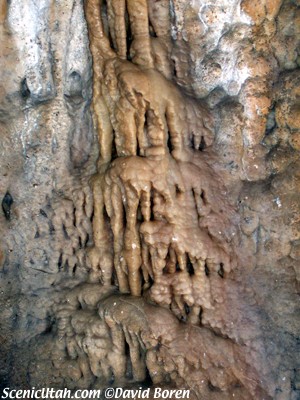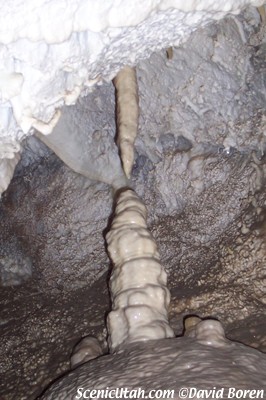Although most everyone in Utah knows about the Timpanogos Cave System (40°26′26″N 111°42′34″W), I felt it appropriate to write up a report on the cave for reference purposes. I’ve only been in Timpanogos Cave once, about four years ago, while taking elementary students for a tour of the cave. We saw a brief portion, but it was none of the less spectacular. I believe the “tourization†of the cave turns many cavers like myself off to the prospects of making a trip to see, but to be honest, some of the most amazing cave formations I’ve seen in Utah can be found here.
Timpanogos Cave is the park's main resource. The cave system is uniquely known for its high abundance of helictites, its coloration in its formations, its display of fault-controlled passages, its alpine surroundings, and unique history.
The 1-1/2 miles long paved trail with a 1,160 feet elevation gain to the cave is also a popular attraction. The trail provides spectular views of the geology of the American Fork Canyon and the expanding cities of the Utah Valley.
Although the park is only 250 acres, it has a respectable diversity in wildlife. The park has sightings recorded for 55 mammal species, 2 fish species, 51 bird species, and 4 reptile species. i.

Helictites are spiral formations that seem to defy gravity. In the Chime Chamber in Timpanogos Cave, there are hundreds of 6 to 10 inch long helictites. These formations are created by capillarity attraction, hydrostatic pressure, and tiny (0.008 to 0.5 millimeter) central canals (Hill & Forti 1997). In simpler words water is pushed and pulled through small opening where the forces of capillarity attraction and hydrostatic pressure are greater than the force of gravity. Timpanogos Cave's abundance in helictites is thought to be caused by the large amounts of wall coatings and the small amount of fault movement that creates many small openings suitable for helictites.
Timpanogos Cave contains formations displaying colors of green and yellow. X-ray analysis shows this rare green and yellow coloring to be from nickel being incorporated into the crystal structure. The X-ray analysis of the yellow flowstone reveals only calcite, and the green flowstone is from mainly Aragonite. (White & Gundy 1974)

The passages in Timpanogos Cave are greatly controlled by faulting. Looking at a map of Timpanogos Cave, one sees many paralleling passages following the fault trends. Along the cave tour, visitors can see these fault lines running along the passages. The initial pathways that water followed were these faults. In some areas of the cave like the Imagination Room, passages dip along the bedding planes and follow the direction of the fault lines. Looking at the map of the cave, one wonders if other cave passages exists following similar fault lines.
Timpanogos Cave is surrounding by an Alpine environment. The cave trail adds to the remoteness of the cave and offering spectacular views of the geology. Unlike other tourist caves, this alpine remoteness is unique. Because of this remoteness, the cave's escapes the polluted air and contaminated watersheds. The cave is closed for 6 months due to heavy snowfalls. The cold environment allows the cave to keep a low stable 45° F (7° C) temperature year around.

Timpanogos Cave was established as a National Monument to preserve its features of unusual scientific interest and importance - features like its abundance of helictites, its coloration in its formations, its display of fault-controlled passages, and its alpine surroundings. ii.
Martin Hansen discovered Hansen Cave in the late 1800s, reportedly while tracking a mountain lion high up the side of American Fork Canyon. Unfortunately, many of this cave's features and formations were damaged or removed over a number of years.
The man who was given credit for discovering Timpanogos Cave was named Vearl J. Manwill. He came with the Payson Outdoors Club in 1921. The club might have come because of rumors of a hidden cave that no one could find. After doing the tour of Hansen's Cave, they all went different ways to try to find the rumored cave. Vearl went up above Hansen's, alone. After a little way, he found a crack, and looked in. He called the rest of the club to come look at what he had found.

That fall, George Heber Hansen and Wayne E. Hansen, Martin Hansen's son and grandson, were hunting on the other side of the canyon. While using binoculars to try to find deer, they came across another hole in the mountain, in between the other two caves. In a few days they came back, with 74 year-old Martin Hansen. Martin was the first human being in the cave, now called Middle Cave.
Fortunately, Middle Cave and Timpanogos Cave were discovered in an era where their formations and resources could be protected. The National Park Service, which oversees and preserves the cave complex, has continued to develop new ways to retain its natural features, including limiting lighting in the caves to retard growth of invasive organisms. iii.
i. http://www.nps.gov/tica/naturescience/index.htm
ii. http://www.nps.gov/tica/naturescience/cave.htm
iii. http://en.wikipedia.org/wiki/Timpano...ional_Monument
Information from nps.gov and wikipedia
Timpanogos Cave is the park's main resource. The cave system is uniquely known for its high abundance of helictites, its coloration in its formations, its display of fault-controlled passages, its alpine surroundings, and unique history.
The 1-1/2 miles long paved trail with a 1,160 feet elevation gain to the cave is also a popular attraction. The trail provides spectular views of the geology of the American Fork Canyon and the expanding cities of the Utah Valley.
Although the park is only 250 acres, it has a respectable diversity in wildlife. The park has sightings recorded for 55 mammal species, 2 fish species, 51 bird species, and 4 reptile species. i.

Helictites are spiral formations that seem to defy gravity. In the Chime Chamber in Timpanogos Cave, there are hundreds of 6 to 10 inch long helictites. These formations are created by capillarity attraction, hydrostatic pressure, and tiny (0.008 to 0.5 millimeter) central canals (Hill & Forti 1997). In simpler words water is pushed and pulled through small opening where the forces of capillarity attraction and hydrostatic pressure are greater than the force of gravity. Timpanogos Cave's abundance in helictites is thought to be caused by the large amounts of wall coatings and the small amount of fault movement that creates many small openings suitable for helictites.
Timpanogos Cave contains formations displaying colors of green and yellow. X-ray analysis shows this rare green and yellow coloring to be from nickel being incorporated into the crystal structure. The X-ray analysis of the yellow flowstone reveals only calcite, and the green flowstone is from mainly Aragonite. (White & Gundy 1974)

The passages in Timpanogos Cave are greatly controlled by faulting. Looking at a map of Timpanogos Cave, one sees many paralleling passages following the fault trends. Along the cave tour, visitors can see these fault lines running along the passages. The initial pathways that water followed were these faults. In some areas of the cave like the Imagination Room, passages dip along the bedding planes and follow the direction of the fault lines. Looking at the map of the cave, one wonders if other cave passages exists following similar fault lines.
Timpanogos Cave is surrounding by an Alpine environment. The cave trail adds to the remoteness of the cave and offering spectacular views of the geology. Unlike other tourist caves, this alpine remoteness is unique. Because of this remoteness, the cave's escapes the polluted air and contaminated watersheds. The cave is closed for 6 months due to heavy snowfalls. The cold environment allows the cave to keep a low stable 45° F (7° C) temperature year around.

Timpanogos Cave was established as a National Monument to preserve its features of unusual scientific interest and importance - features like its abundance of helictites, its coloration in its formations, its display of fault-controlled passages, and its alpine surroundings. ii.
Martin Hansen discovered Hansen Cave in the late 1800s, reportedly while tracking a mountain lion high up the side of American Fork Canyon. Unfortunately, many of this cave's features and formations were damaged or removed over a number of years.
The man who was given credit for discovering Timpanogos Cave was named Vearl J. Manwill. He came with the Payson Outdoors Club in 1921. The club might have come because of rumors of a hidden cave that no one could find. After doing the tour of Hansen's Cave, they all went different ways to try to find the rumored cave. Vearl went up above Hansen's, alone. After a little way, he found a crack, and looked in. He called the rest of the club to come look at what he had found.

That fall, George Heber Hansen and Wayne E. Hansen, Martin Hansen's son and grandson, were hunting on the other side of the canyon. While using binoculars to try to find deer, they came across another hole in the mountain, in between the other two caves. In a few days they came back, with 74 year-old Martin Hansen. Martin was the first human being in the cave, now called Middle Cave.
Fortunately, Middle Cave and Timpanogos Cave were discovered in an era where their formations and resources could be protected. The National Park Service, which oversees and preserves the cave complex, has continued to develop new ways to retain its natural features, including limiting lighting in the caves to retard growth of invasive organisms. iii.
i. http://www.nps.gov/tica/naturescience/index.htm
ii. http://www.nps.gov/tica/naturescience/cave.htm
iii. http://en.wikipedia.org/wiki/Timpano...ional_Monument
Information from nps.gov and wikipedia